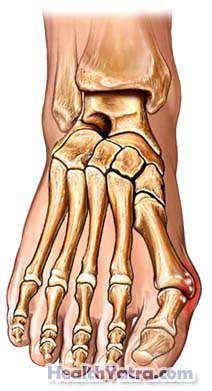تعريف
A bunion removal is a surgery to repair a deformity in the joint that connects the big toe to the foot. It is done by removing excess bone in the joint area.

أسباب هذا الإجراء
A bunion is an inflammation and enlargement of the big toe joint and the tissue around it. In some cases, the deformity is so severe that the big toe begins to slant toward the outside of the foot. Surgery to correct it is considered when:
- Other attempts at therapy have failed, such as anti-inflammatory drugs, physical therapy, specially shaped shoes, or inserts to decrease pressure
- The pain of a bunion interferes with walking
- The foot deformity makes walking difficult
المضاعفات المحتملة
If you are planning to have a bunion removal, your سيقوم الطبيب بمراجعة القائمة من المضاعفات المحتملة، والتي قد تشمل:
- تورم
- العدوى
- نزيف
- Toe may be misaligned or too short
- The bunion may recur
تشمل العوامل التي قد تزيد من خطر حدوث مضاعفات ما يلي:
- Smoking and alcohol abuse
- مرض السكري
- سوء التغذية
- Poor health
ما يمكن توقعه
قبل الإجراء
طبيبك سوف المرجح أن تفعل ما يلي:
- Physical exam, especially of your foot
- Foot x-rays
- Blood work
المؤدية إلى الإجراء الخاص بك:
- التحدث مع طبيبك عن الأدوية الخاصة بك. قد يطلب منك التوقف عن تناول بعض الأدوية تصل إلى أسبوع واحد قبل العملية مثل:
- الأدوية المضادة للالتهابات مثل الأسبرين
- مميعات الدم
- للترتيب من الإجراء.
- رتبي للحصول على المساعدة في المنزل بعد العملية.
- في الليلة السابقة ، تناول وجبة خفيفة. لا تأكل أو تشرب أي شيء بعد منتصف الليل.
- قد يُطلب منك الاستحمام في صباح يوم عمليتك. قد يُطلب منك استخدام صابون خاص مضاد للبكتيريا.
التخدير
Depending on the complexity of the surgery, you may be given:
- Local anesthesia—The area will be numbed.
- General anesthesia—You will be asleep.
وصف الإجراء
There are several types of bunion removal procedures. Generally, the doctor will cut into the foot near the bunion. The excess growth of bone will be removed with a bone saw. Depending on the degree of deformity, the doctor may need to cut into the bone of the toe. The bones will then be realigned so that the toe no longer slants to the outside. Other revisions may be needed as well. Improving the angle of the toe and repairing these bones may require a metal pin, screw, or rod to hold the bones in place. The incisions will be closed with stitches. A bulky bandage will be placed over the area.
كم من الوقت سيستغرق ؟
Anywhere from less than 30 minutes to over 2 hours
هل ستسبب الالم؟
Anesthesia prevents pain during surgery. You will have pain after the surgery. Talk to your doctor about medicine to help manage the pain.
متوسط الإقامة في المستشفى
You may be released the same day or need to stay in the hospital overnight.
الرعاية ما بعد الجراحة
- Your foot will be bandaged. You may need to wear a special postoperative shoe for several weeks.
- You will be given instructions about whether you may bear weight on your foot. You may need to wear a splint or cast. You may need to use crutches or a walker for a brief time.
- To keep the swelling down, you should ice your foot. Wrap ice in a towel. Do not apply it directly to your skin. Keep your foot elevated on pillows for several days.
- After your foot has healed, you may need to do specific exercises or physical therapy. They will help you regain strength, flexibility, and stamina in your feet.
- Talk with your doctor about the kind of footwear you should use. Make sure that it fits correctly.
- If pins were used in your feet, you may need to have these removed several weeks after your operation.
- اسأل طبيبك حول, عندما هي آمنة للاستحمام, السباحة, أو نقع في الماء.
- تأكد من اتباع تعليمات طبيبك.
Bunion removal may result in better movement with less pain. It may take as long as eight weeks after bunion surgery for your foot to be well-healed.
استدعاء الطبيب
بعد وصوله الى المنزل ، اتصل بطبيبك إذا كان أي من الحالات التالية:
- علامات الإصابة, بما في ذلك حمى وقشعريرة
- احمرار أو تورم أو ألم متزايد أو نزيف مفرط أو أي إفرازات من الموقع
- سعال أو ضيق في التنفس أو ألم في الصدر
- ألم لا يمكنك السيطرة عليه بالأدوية التي أعطيت لك
- Nausea and/or vomiting that you cannot control with the medicines you were given after surgery or which persist for more than two days after discharge from the hospital
- Swelling or pain in the calf or leg
في حالة الطوارئ ، اتصل على المساعدة الطبية على الفور.
